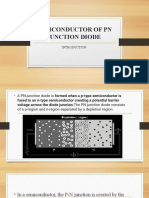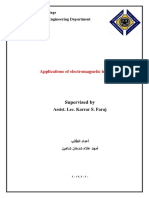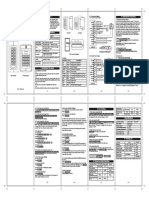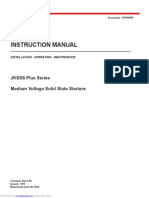0 ratings0% found this document useful (0 votes)
25 viewsAss#1
Ass#1
Uploaded by
Jay EyThe document discusses direct current (DC) generators. It describes different types of DC generators including permanent magnet, separately excited, and self-excited generators. The principles of electromagnetic induction and the basic construction of a DC generator including its field and armature windings are explained. DC generators are classified based on their field excitation methods. Types of armatures and armature windings are also discussed. Compensating windings and interpoles are described as methods used for proper commutation and to reduce armature reaction. The document concludes by covering generator voltage output and regulation.
Copyright:
© All Rights Reserved
Available Formats
Download as DOCX, PDF, TXT or read online from Scribd
Ass#1
Ass#1
Uploaded by
Jay Ey0 ratings0% found this document useful (0 votes)
25 views4 pagesThe document discusses direct current (DC) generators. It describes different types of DC generators including permanent magnet, separately excited, and self-excited generators. The principles of electromagnetic induction and the basic construction of a DC generator including its field and armature windings are explained. DC generators are classified based on their field excitation methods. Types of armatures and armature windings are also discussed. Compensating windings and interpoles are described as methods used for proper commutation and to reduce armature reaction. The document concludes by covering generator voltage output and regulation.
Copyright
© © All Rights Reserved
Available Formats
DOCX, PDF, TXT or read online from Scribd
Share this document
Did you find this document useful?
Is this content inappropriate?
The document discusses direct current (DC) generators. It describes different types of DC generators including permanent magnet, separately excited, and self-excited generators. The principles of electromagnetic induction and the basic construction of a DC generator including its field and armature windings are explained. DC generators are classified based on their field excitation methods. Types of armatures and armature windings are also discussed. Compensating windings and interpoles are described as methods used for proper commutation and to reduce armature reaction. The document concludes by covering generator voltage output and regulation.
Copyright:
© All Rights Reserved
Available Formats
Download as DOCX, PDF, TXT or read online from Scribd
Download as docx, pdf, or txt
0 ratings0% found this document useful (0 votes)
25 views4 pagesAss#1
Ass#1
Uploaded by
Jay EyThe document discusses direct current (DC) generators. It describes different types of DC generators including permanent magnet, separately excited, and self-excited generators. The principles of electromagnetic induction and the basic construction of a DC generator including its field and armature windings are explained. DC generators are classified based on their field excitation methods. Types of armatures and armature windings are also discussed. Compensating windings and interpoles are described as methods used for proper commutation and to reduce armature reaction. The document concludes by covering generator voltage output and regulation.
Copyright:
© All Rights Reserved
Available Formats
Download as DOCX, PDF, TXT or read online from Scribd
Download as docx, pdf, or txt
You are on page 1of 4
Ajeto, Joshua Allen D.
BSME III
EE 330 B
Assignment no.1
1. What is an Electrical Generator?
Electric generators, also known as dynamos is an electric
machine that converts mechanical energy into electrical
energy. The electric generator’s mechanical energy is
usually provided by steam turbines, gas turbines, and wind
turbines. Electrical generators provide nearly all the power
that is required for electric power grids.
2. Types of Direct Current Generators
Permanent Magnet Type DC Generator
Here, no field windings are present near the poles. The
poles produce constant fields here. This is very small and
used in dynamos in cycles etc. The magnets produce flux
which gets deteriorated with the passage of time and indeed
changes the characteristics of the machine.
Separately Excited DC Generator
Here, the field windings are energized by a separate DC
source. The flux generated on the poles depends upon the
field current, and the saturated region remains constant.
Self Excited DC Generator
The generator provides the current to the field winding.
When the electric generator is off, a small is developed in
the rotor which induces an electromotive force in the
armature and produces current in the field windings.
The self-excited DC generator is further classified into
Shunt Wound Generator and Series Wound Generator.
Shunt Wound Generator
Here, the field winding is connected across the armature
windings in a parallel also known as a shunt circuit, which
helps to apply a full terminal voltage across it.
Series Wound Generator
Here, the field coils are connected in series with the
armature windings. The armature current is carried in a
series of field windings.
3. Principles of operation of DC Generator
A direct current generator works on the concept of
electromagnetic induction, which states that when the
magnetic flux between two conductors changes, an EMF is
induced in the conductor. A field winding and an armature
winding are both included in a DC generator.
4. Illustration and construction of the main parts of a practical
DC Gen and each function.
5. DC Generator Classifications
DC generators are mainly categorized into three types based
on the field excitation methods. They are;
Permanent Magnet DC generator is a device that converts
mechanical energy to electrical energy. In this device the
rotor windings have been replaced with permanent magnets.
These devices do not require a separate DC supply for the
excitation circuit or do they have slip rings and contact
brushes.
Separately Excited DC generator is the one whose field
winding is supplied by an independent external DC source
(like a battery).
Self-Excited DC generator, a elf-excited generators which
get started with the initial current in the field coils.
6. Types of Armatures and types of Armature windings.
7. Compensating windings and Interpoles
Compensating winding and interpoles are used for same
purpose but the difference between them is, interpoles
produce e.m.f for neutralizing reactance e.m.f whereas
compensating winding produces an m.m.f which opposes the
m.m.f produced by conductors.
8. Proper Commutation and Armature Reaction in DC Gen.
For the same, compensating winding and interpoles are
utilized, yet the distinction between them is that
interpoles create lectromotive force for reactance
neutralization electromotive force. Magnetomotive force is
produced via compensatory winding.
a force that opposes the Magnetomotive force generated by
conductors.
9. Generator Voltage Output and Voltage Regulation.
Voltage regulation is the measure of how well a power
transformer can maintain constant secondary voltage given a
constant primary voltage and wide variance in load current.
The lower the percentage (closer to zero), the more stable
the secondary voltage and the better the regulation it will
provide. A generator's output is generally regulated by
adjusting the current in the generator's field, with the
speed remaining constant for a given frequency. There are
several excitation systems that may be used, and they all
typically comprise some sort of system of detecting and
regulating the output voltage of the generator
You might also like
- The Subtle Art of Not Giving a F*ck: A Counterintuitive Approach to Living a Good LifeFrom EverandThe Subtle Art of Not Giving a F*ck: A Counterintuitive Approach to Living a Good LifeRating: 4 out of 5 stars4/5 (5935)
- The Gifts of Imperfection: Let Go of Who You Think You're Supposed to Be and Embrace Who You AreFrom EverandThe Gifts of Imperfection: Let Go of Who You Think You're Supposed to Be and Embrace Who You AreRating: 4 out of 5 stars4/5 (1106)
- Never Split the Difference: Negotiating As If Your Life Depended On ItFrom EverandNever Split the Difference: Negotiating As If Your Life Depended On ItRating: 4.5 out of 5 stars4.5/5 (879)
- Grit: The Power of Passion and PerseveranceFrom EverandGrit: The Power of Passion and PerseveranceRating: 4 out of 5 stars4/5 (598)
- Hidden Figures: The American Dream and the Untold Story of the Black Women Mathematicians Who Helped Win the Space RaceFrom EverandHidden Figures: The American Dream and the Untold Story of the Black Women Mathematicians Who Helped Win the Space RaceRating: 4 out of 5 stars4/5 (925)
- Shoe Dog: A Memoir by the Creator of NikeFrom EverandShoe Dog: A Memoir by the Creator of NikeRating: 4.5 out of 5 stars4.5/5 (545)
- The Hard Thing About Hard Things: Building a Business When There Are No Easy AnswersFrom EverandThe Hard Thing About Hard Things: Building a Business When There Are No Easy AnswersRating: 4.5 out of 5 stars4.5/5 (353)
- Elon Musk: Tesla, SpaceX, and the Quest for a Fantastic FutureFrom EverandElon Musk: Tesla, SpaceX, and the Quest for a Fantastic FutureRating: 4.5 out of 5 stars4.5/5 (476)
- Her Body and Other Parties: StoriesFrom EverandHer Body and Other Parties: StoriesRating: 4 out of 5 stars4/5 (831)
- The Emperor of All Maladies: A Biography of CancerFrom EverandThe Emperor of All Maladies: A Biography of CancerRating: 4.5 out of 5 stars4.5/5 (274)
- The Little Book of Hygge: Danish Secrets to Happy LivingFrom EverandThe Little Book of Hygge: Danish Secrets to Happy LivingRating: 3.5 out of 5 stars3.5/5 (419)
- The World Is Flat 3.0: A Brief History of the Twenty-first CenturyFrom EverandThe World Is Flat 3.0: A Brief History of the Twenty-first CenturyRating: 3.5 out of 5 stars3.5/5 (2271)
- The Yellow House: A Memoir (2019 National Book Award Winner)From EverandThe Yellow House: A Memoir (2019 National Book Award Winner)Rating: 4 out of 5 stars4/5 (99)
- Devil in the Grove: Thurgood Marshall, the Groveland Boys, and the Dawn of a New AmericaFrom EverandDevil in the Grove: Thurgood Marshall, the Groveland Boys, and the Dawn of a New AmericaRating: 4.5 out of 5 stars4.5/5 (270)
- The Sympathizer: A Novel (Pulitzer Prize for Fiction)From EverandThe Sympathizer: A Novel (Pulitzer Prize for Fiction)Rating: 4.5 out of 5 stars4.5/5 (122)
- Team of Rivals: The Political Genius of Abraham LincolnFrom EverandTeam of Rivals: The Political Genius of Abraham LincolnRating: 4.5 out of 5 stars4.5/5 (235)
- A Heartbreaking Work Of Staggering Genius: A Memoir Based on a True StoryFrom EverandA Heartbreaking Work Of Staggering Genius: A Memoir Based on a True StoryRating: 3.5 out of 5 stars3.5/5 (232)
- On Fire: The (Burning) Case for a Green New DealFrom EverandOn Fire: The (Burning) Case for a Green New DealRating: 4 out of 5 stars4/5 (75)
- Elements of Mechanism Sixth Edition - TextDocument446 pagesElements of Mechanism Sixth Edition - TextJay Ey100% (1)
- The Unwinding: An Inner History of the New AmericaFrom EverandThe Unwinding: An Inner History of the New AmericaRating: 4 out of 5 stars4/5 (45)
- Abigail EE 330 Assignment 7Document12 pagesAbigail EE 330 Assignment 7Jay EyNo ratings yet
- Assignment # 7Document14 pagesAssignment # 7Jay EyNo ratings yet
- Assignment #. 3 PDFDocument4 pagesAssignment #. 3 PDFJay EyNo ratings yet
- Diode Equivalent ModelsDocument9 pagesDiode Equivalent ModelsJay Ey0% (1)
- Semiconductor PN Junction DiodeDocument59 pagesSemiconductor PN Junction DiodeJay EyNo ratings yet
- Applications of Electromagnetic InductionDocument6 pagesApplications of Electromagnetic InductionLivombo AveloNo ratings yet
- Sound Convert To Electric EnergyDocument4 pagesSound Convert To Electric EnergyHamrin MuhammadNo ratings yet
- Differences Between Shunt Reactor and Power TransformerDocument4 pagesDifferences Between Shunt Reactor and Power TransformerUalahMakjanNo ratings yet
- 01a 02a PROT409 SynchronousGenerator 20230703Document88 pages01a 02a PROT409 SynchronousGenerator 20230703Álex NágutNo ratings yet
- (NEOM-NEG-EMR-002 Rev. 4.2) Design Basis Document Part 2 - DesignDocument37 pages(NEOM-NEG-EMR-002 Rev. 4.2) Design Basis Document Part 2 - DesignrwaaabdelmagedNo ratings yet
- Biblio PDFDocument2 pagesBiblio PDFvampakkNo ratings yet
- True Wireless: ManualDocument42 pagesTrue Wireless: ManualMike RAMÍREZNo ratings yet
- W1 W3-B-C User ManualDocument1 pageW1 W3-B-C User Manualamad4youNo ratings yet
- A Practical Handbook of Speech CodersDocument13 pagesA Practical Handbook of Speech CodersVany BraunNo ratings yet
- Evolution of Electronics and Its ApplicationsDocument11 pagesEvolution of Electronics and Its ApplicationsDebasish MishraNo ratings yet
- Terasaki MV BreakersDocument20 pagesTerasaki MV BreakersnicholasleeNo ratings yet
- Automatic Pill DispenserDocument22 pagesAutomatic Pill Dispenserakashlogic100% (1)
- 9.3 Impedansi Dan AdmitansiDocument9 pages9.3 Impedansi Dan AdmitansiDimas Fahrezi HartonoNo ratings yet
- Interrupts: 11.1 Interrupt Vectors in Atmega328PDocument1 pageInterrupts: 11.1 Interrupt Vectors in Atmega328PnamerNo ratings yet
- 6b1a02b822103dc01379ddd098c0bc96Document18 pages6b1a02b822103dc01379ddd098c0bc96Farman ilahiNo ratings yet
- Characteristics and Service of A/C System: Making Refined Cars For EveryoneDocument22 pagesCharacteristics and Service of A/C System: Making Refined Cars For Everyoneesteban ismael fernandez dominguezNo ratings yet
- S6A PositionerDocument4 pagesS6A Positionermohammad hossein jafariNo ratings yet
- Dl8000 Preset ControllerDocument74 pagesDl8000 Preset ControllerFIRMANSYAHNo ratings yet
- PLF Plantwise - 2023-24Document4 pagesPLF Plantwise - 2023-24Bhavitha GjNo ratings yet
- ManualDocument106 pagesManualEmmanuel EntzanaNo ratings yet
- Boolean Algebra and Logic Gates: Basic TheoremsDocument18 pagesBoolean Algebra and Logic Gates: Basic Theoremsalma bella macaldoNo ratings yet
- S.5 Phy P2Document8 pagesS.5 Phy P2kaziba stephenNo ratings yet
- AD758V - OPL SpecificationsDocument2 pagesAD758V - OPL Specificationsmairimsp2003No ratings yet
- Eaton PTC Resettable Fuse Application GuidelinesDocument4 pagesEaton PTC Resettable Fuse Application GuidelinesAlexis KosmidisNo ratings yet
- Data Center in General by Matthew Sacha 20210224Document1 pageData Center in General by Matthew Sacha 20210224Matthew SachaNo ratings yet
- TOKAFlex Metric Imperial Spec Sheet Gecko Robotics 2021Document1 pageTOKAFlex Metric Imperial Spec Sheet Gecko Robotics 2021gorkembaytenNo ratings yet
- IALA Maritime Radio Communications PlanDocument57 pagesIALA Maritime Radio Communications Plansanjin_valcicNo ratings yet
- Electric Fuses 0863413994Document262 pagesElectric Fuses 0863413994Lidija Preljvukić100% (2)
- Design Transmission Tower and Its FoundationDocument7 pagesDesign Transmission Tower and Its FoundationApple Electricals100% (1)
- Mojo Classic Quick GuideDocument2 pagesMojo Classic Quick GuideLouis LukenNo ratings yet












































































